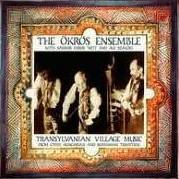 Brendan Foreman penned this review.
Brendan Foreman penned this review.
The music of Transylvania reflects the many cultures that have inhabited it: Romanian, Hungarian, Romany, even some Jewish and German. It’s a haunting, rough style of music, featuring strange harmonies, microtonal note, and some very sophisticated violin work. For this CD, the Okros Ensemble has gone to great lengths to celebrate each one of these aspects of Transylvanian village music, from recruiting the impressive playing of the master Transylvanian violinist Sandor “Neti” Fodor to even recreating the music of a medieval Grand Ball from one of the better times of Transylvanian history.
Consisting of Csaba Okros and Miklos Molnar on the violins, Laszlo Mester and Laszlo Kelemen on the violas, Robert Door on the double bass, and Kalman Balogh on the cimbalom, the Okros Ensemble is a group of six Hungarian musicians who have been involved in the Eastern European revivalist scene since well before the Iron Curtain fell.
To many an untrained Western ear, this music can have a jolting, often unpleasant quality with its very complex and unusual harmony patterns, made even more so by the violinists’ tendencies to use microtones, i.e. the notes between the standard A, A sharp, B, C, etc. However, with repeated listens, this music will reveal its beauty, especially if it is played the way it was meant to be: very loud.
The first track is a driving set of wedding tunes, consisting of a Hungarian’s men’s dance tune called a “legenyes” and a very fast couple dance called a “friss.” Like most traditional dance pieces, these tunes are played fairly long (the legenyes lasts for five minutes). Yet the Ensemble — and, most notably, Neti Fodor on lead violin — is continuously changing the music, either improvising on the theme or adding new harmonies and rhythms.
Neti Fodor and the Ensemble keep up these amazing dynamics even for the slow lament “Komos Hallgotoja” of the second track. Although it’s a tune that consists mostly of long bow strokes, Neti and the Ensemble manage to keep this interesting up to four minutes with their subtle transformations of the original tune.
In a few tracks, the Ensemble is joined by singer Agi Szaloki. She sings the a cappella Gypsy lament “Cigany Keserves” in sung in three languages: Romanian, Hungarian, and Roma. This beautiful song is meant to represent the three cultures living in harmony in Transylvania.
On a later track, she sings “Szaloki Agi Keservese” (Agi Szaloki’s Lamenting Song). The Keservese is an improvised, often free-style song reflecting the sad fate of the Transylvanians. Here Agi’s beautiful almost drone-like voice is perfectly matched by a wailing ensemble of violins, the lead played by Laka Aladar “Kicsi,” a contemporary of Neti Fodor.
The middle two tracks of this CD are medieval dance pieces from the Bonchida region of Transylvania. This area was once quite prosperous, while being managed by the Count Banffy family, and has been a great resource of traditional music for the Ensemble. In recognition of these facts, the Okros Ensemble has reconstructed the music of a Grand Ball as it may have been performed during the days of the Banffy court.
The first track, a very old Romanian turning dance called an “invirtita,” begins with a stately solo violin, backed rhythmically by another. Gradually, the other violins and strings join in, forming a mesh of strange harmony and complicated rhythm. By the end, a cavalcade of strings — including Kalman Balogh on cimbalom — are all contributing to this regal dance tune.
The second track of this Grand Ball is a medley of three tunes. Beginning with “Ritka Magyar,” a slow yet bouncy Hungarian’s men’s dance featuring the full ensemble and some gorgeous soloing from “Neti” Sandor, it picks up the tempo — as well as some playful vocals from Agi Szaloki — with the Gypsy song “Cigany Csardas.” The ensemble ends the set with a very brisk dance song called “Csingerlas.” Kalman Balogh’s cimbalom provides a consistent, driving rhythmic force to this exciting piece. Even Szaloki’s vocals becomes more and more a rhythm instrument as she begins to improvise more and more near the end.
The closing track of the CD is a long set containing some of “Neti”‘s most amazing music. The first tune is a slow, languorous violin ensemble piece called a “Hajnall” (meaning “blues”). The tempo is deceptively slow; careful listening will reveal some amazingly complicated — and fast — lead violin work. The Ensemble picks up speed with a “Csardas.” After some very high-pitched harmony work, this segues into “Friss,” a faster tune with a heavy rhythm part.
With this CD, the Okros Ensemble has created an essential body of Eastern European traditional music. Played with verve and love and spanning a nice cross-section of cultures, this music is rough, complex, and extraordinarily beautiful.
(Rounder, 1999)
